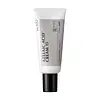What's inside
What's inside
 Key Ingredients
Key Ingredients

 Benefits
Benefits

 Concerns
Concerns

No concerns
 Ingredients Side-by-side
Ingredients Side-by-side

Water
Skin ConditioningAzelaic Acid
BufferingButylene Glycol
HumectantMethylheptyl Laurate
EmollientDodecane
PerfumingPentylene Glycol
Skin ConditioningSqualane
EmollientGlyceryl Stearate
EmollientBehenyl Alcohol
EmollientHydrogenated Lecithin
EmulsifyingGlyceryl Behenate
EmollientPolyglyceryl-6 Octastearate
EmulsifyingDipotassium Glycyrrhizate
HumectantSodium Hyaluronate
HumectantCentella Asiatica Extract
CleansingScutellaria Baicalensis Root Extract
Astringent(Licorice/Reynoutria Japonica) Root/Stem Extract
AntioxidantGlycyrrhiza Glabra Root Extract
BleachingMelaleuca Alternifolia Leaf Extract
PerfumingRosmarinus Officinalis Leaf Extract
AntimicrobialAnthemis Nobilis Flower Extract
MaskingHydroxyethylcellulose
Emulsion StabilisingZinc Borosilicate
Silver Oxide
AntimicrobialWater, Azelaic Acid, Butylene Glycol, Methylheptyl Laurate, Dodecane, Pentylene Glycol, Squalane, Glyceryl Stearate, Behenyl Alcohol, Hydrogenated Lecithin, Glyceryl Behenate, Polyglyceryl-6 Octastearate, Dipotassium Glycyrrhizate, Sodium Hyaluronate, Centella Asiatica Extract, Scutellaria Baicalensis Root Extract, (Licorice/Reynoutria Japonica) Root/Stem Extract, Glycyrrhiza Glabra Root Extract, Melaleuca Alternifolia Leaf Extract, Rosmarinus Officinalis Leaf Extract, Anthemis Nobilis Flower Extract, Hydroxyethylcellulose, Zinc Borosilicate, Silver Oxide
Water
Skin ConditioningAzelaic Acid
BufferingButylene Glycol
HumectantTriethylhexanoin
MaskingParaffinum Liquidum
EmollientCaprylic/Capric Triglyceride
MaskingDiglycerin
HumectantPentylene Glycol
Skin ConditioningGlyceryl Stearate
EmollientSimmondsia Chinensis Seed Oil
EmollientPEG-60 Hydrogenated Castor Oil
EmulsifyingNylon-12
Cetearyl Alcohol
EmollientAmmonium Acryloyldimethyltaurate/Vp Copolymer
Hydroxypropyl Methylcellulose Stearoxy Ether
Disodium EDTA
Water, Azelaic Acid, Butylene Glycol, Triethylhexanoin, Paraffinum Liquidum, Caprylic/Capric Triglyceride, Diglycerin, Pentylene Glycol, Glyceryl Stearate, Simmondsia Chinensis Seed Oil, PEG-60 Hydrogenated Castor Oil, Nylon-12, Cetearyl Alcohol, Ammonium Acryloyldimethyltaurate/Vp Copolymer, Hydroxypropyl Methylcellulose Stearoxy Ether, Disodium EDTA
 Reviews
Reviews

Ingredients Explained
These ingredients are found in both products.
Ingredients higher up in an ingredient list are typically present in a larger amount.
Azelaic acid is a multitasker ingredient that helps treat acne, pigmentation, and irritation. It is a great option for sensitive skin.
What makes azelaic special?
The best thing about azelaic acid is it's gentleness. It's generally well-tolerated and safe to use alongside other actives like niacinamide or salicylic acid.
Unlike AHAs, azelaic acid will not make you photosensitive/sun sensitive.
You can find this ingredient naturally occurring in grains like wheat, rye, and barley. In cosmetics, azelaic acid is typically lab-made, which is more stable and effective.
Learn more about Azelaic AcidButylene Glycol (or BG) is used within cosmetic products for a few different reasons:
Overall, Butylene Glycol is a safe and well-rounded ingredient that works well with other ingredients.
Though this ingredient works well with most skin types, some people with sensitive skin may experience a reaction such as allergic rashes, closed comedones, or itchiness.
Learn more about Butylene GlycolGlyceryl Stearate is a mix of glycerin and stearic acid.
It is used to stabilize the mixing of water and oil ingredients. By preventing these ingredients from separating, it can help elongate shelf life. It can also help thicken the product's texture.
As an emollient, it helps soften skin and supports barrier-replenishing ingredients.
In cosmetics, Glyceryl Stearate is often made from vegetable oils or synthetically produced.
This ingredient may not be fungal-acne safe
Fun fact: The human body also creates Glyceryl Stearate naturally.
Learn more about Glyceryl StearatePentylene glycol is typically used within a product to thicken it. It also adds a smooth, soft, and moisturizing feel to the product. It is naturally found in plants such as sugar beets.
The hydrophilic trait of Pentylene Glycol makes it a humectant. As a humectant, Pentylene Glycol helps draw moisture from the air to your skin. This can help keep your skin hydrated.
This property also makes Pentylene Glycol a great texture enhancer. It can also help thicken or stabilize a product.
Pentylene Glycol also acts as a mild preservative and helps to keep a product microbe-free.
Some people may experience mild eye and skin irritation from Pentylene Glycol. We always recommend speaking with a professional about using this ingredient in your routine.
Pentylene Glycol has a low molecular weight and is part of the 1,2-glycol family.
Learn more about Pentylene GlycolWater. It's the most common cosmetic ingredient of all. You'll usually see it at the top of ingredient lists, meaning that it makes up the largest part of the product.
So why is it so popular? Water most often acts as a solvent - this means that it helps dissolve other ingredients into the formulation.
You'll also recognize water as that liquid we all need to stay alive. If you see this, drink a glass of water. Stay hydrated!
Learn more about Water